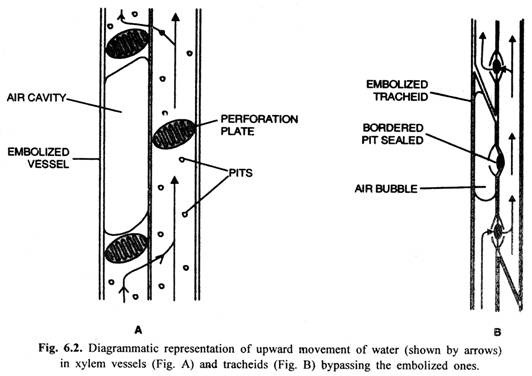ADVERTISEMENTS:
In this article we will discuss about the cavitation and embolism phenomenon in vascular plants.
Cavitation:
Cavitation (L. Cavus, hollow) is the phenomenon of gas or vapour filled cavities in liquids in motion in a region where the pressure of the liquid falls below its vapour pressure. Cavitation occurs in xylem of vascular plants when the tension of water within the xylem becomes so high that dissolved air within water expands to fill either the vessels or the tracheids. The blocking of a xylem vessel or tracheid by an air bubble or cavity is called as embolism (Gr. embolus, stopper), and such a vessel or tracheid is said to be embolized. In scientific literature however, both cavitation and embolism are very often treated as one and the same.
As has been described earlier, the ascent of sap in vascular plants takes place through xylem. The mature vessels or tracheids (which are dead and consist of only thick cell walls) are compactly packed and form conduits for the upward movement of water through them.
ADVERTISEMENTS:
The vessels are present one above the other with perforated end plates (or walls) and pitted side walls making perfect conduits for continuity of the water column inside them. In gymnosperms, where usually vessels are absent, the tracheids form the water conduits. Although tracheids are not placed end to end, but they are interconnected due to presence of large number of bordered pits on their walls for continuity of water column (Fig. 6.2B).
If cavitation or embolism occurs only in a few xylem vessels or tracheids, the upward movement of water may continue uninterrupted through adjacent un-embolized xylem vessels or tracheids bypassing the un-embolized ones (Fig. 6.2). But, widespread cavitation or embolism in xylem (as under severe water stress) reduces a plant’s capacity to transport water from soil to leaves. This reduction in xylem’s hydraulic conductivity can impair rate of carbon fixation by inducing stomatal closure to prevent further cavitation and desiccation of leaf tissues.
In some trees, the sound of cavitation is clearly audible particularly in summer when the rate of evapotranspiration is highest. Deciduous trees shed leaves in the autumn partly because cavitation increases with decreased temperatures. (The air bubble may expand in xylem vessels through perforation plates, but ultimately will be stopped by an imperforate end wall. In. both xylem vessels and tracheids, surface tension prevents the air bubbles from squeezing through small pits and capillary pores in the side walls).
Mechanisms of Embolism Formation:
ADVERTISEMENTS:
(i) Water Stress-Induced Embolism:
Under severe water stress, tension of water in xylem becomes so high that dissolved air within water expands to fill either the vessel or tracheid elements and cavitation occurs. The length of the conduit formed by xylem vessels or tracheids, diameter of the conduit, and size of the pits or bordered pits play important role in cavitation and embolism. There is considerable evidence that water stress-induced embolism occurs by air seeding at pores in the inter-vessels or inter-tracheids pit membranes.
(ii) Embolism Formation by Winter Freezing:
Embolism formation by winter freezing has been observed in many plants such as sugar maple (Acer saccharum) and grapevine (Vitis spp.). Several studies have shown that when xylem is frozen while under tension, extensive embolism develops after thaw (melting of ice) as air bubbles forced out of solution during freezing expand and nucleate cavitation. Embolisms may also form in frozen vessels by sublimation.
(iii) Pathogen-Induced Embolism:
It has been known for quite some time that vascular diseases caused by pathogens induce water-stress in host by reducing the hydraulic conductivity of the xylem and formation of embolism.
Detection of Xylem Cavitation and Embolism:
There are two main methods for detection of xylem cavitation:
(i) Acoustic detection of cavitation, and
(ii) Hydraulic detection of embolism. (acoustics = study of sound and sound waves).
Embolism Repair:
ADVERTISEMENTS:
Plants adopt various strategies to avoid long term damage caused by embolism:
1. An effective method of repairing embolism in herbaceous plants occurs at night when transpiration is low or absent and root pressure is high. Under such situation, root pressure generates positive xylem pressure which reduces tension in xylem water and allows air to re-dissolve in the xylem solution. But, how embolism might be reversed in tall trees is not so clear. However, positive xylem pressures have been observed in trees such as sugar maple and woody vines in spring and those plants are known to recover from freezing- induced embolisms in spring.
2. Another effective mechanism to restore hydraulic conductivity in xylem after cavitation is to produce new xylem conduits in those plants which possess capacity for secondary growth. New xylem vessels and tracheids produced each spring in such plants (shrubs or trees) replace the older cavitated and non-functional xylem conduits which may fulfill the hydraulic conductivity needs of these plants.

